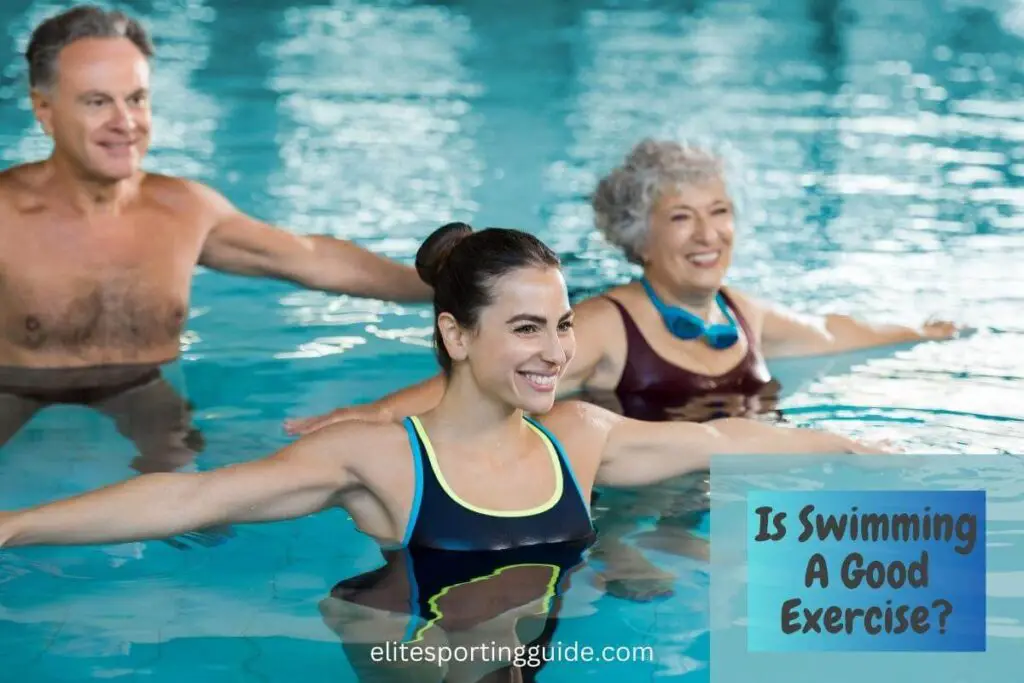In this article, we search into the question, “Is Swimming A Good Exercise?”
We look into the multifaceted advantages of swimming, ranging from its comprehensive full-body workout to its low-impact nature, which makes it accessible to a wide range of individuals.
Is Swimming A Good Exercise?
Yes, swimming is an excellent form of exercise. It provides a full-body workout that improves cardiovascular fitness, builds muscle strength, and enhances flexibility while being low-impact on joints, making it suitable for people of all ages and fitness levels. Swimming is also an effective way to burn calories and improve overall physical health.
The Versatility of Swimming
Swimming is a versatile exercise that engages multiple muscle groups, making it a full-body workout.
Different strokes, such as freestyle, breaststroke, backstroke, and butterfly, target various muscle sets, promoting overall muscular strength and endurance.
Additionally, the resistance provided by the water forces your muscles to work harder, contributing to toning and sculpting.
Cardiovascular fitness is another area where swimming shines.
It elevates your heart rate and improves lung capacity, helping to enhance your cardiovascular health.
Regular swimming can lead to better circulation, lower blood pressure, and improved cholesterol levels.
The versatility of swimming extends to people of all fitness levels.
It’s a great exercise choice for beginners looking to start a fitness routine and for elite athletes seeking cross-training options.
The water’s buoyancy reduces the impact on joints, making it suitable for those with joint problems or injuries.
This adaptability allows individuals to tailor their swimming workouts to match their specific fitness goals and physical capabilities.
Low-Impact, Joint-Friendly Exercise
Low-impact, joint-friendly exercises are forms of physical activity that minimize stress and strain on the joints, particularly the knees, hips, and ankles.
These exercises are gentle on the body’s musculoskeletal system, making them ideal for people with joint issues, arthritis, or those who want to reduce the risk of injury.
Here are some examples of low-impact, joint-friendly exercises:
1. Swimming: Swimming is often considered the gold standard for low-impact exercise.
The buoyancy of the water supports the body, reducing the impact on joints while providing a full-body workout.
2. Cycling: Riding a bicycle, particularly on flat terrain or using a stationary bike, is low-impact and easy on the joints. It strengthens leg muscles without putting excessive stress on the knees.
3. Elliptical Training: Elliptical machines simulate a running motion without the jarring impact associated with running on hard surfaces. They provide a cardiovascular workout while being gentle on the joints.
4. Water Aerobics: Water aerobics classes involve performing aerobic exercises in the water.
The water’s resistance and buoyancy protect joints while allowing for a challenging workout.
5. Yoga: Yoga is a low-impact exercise that focuses on flexibility, balance, and strength. It includes poses and stretches that can be adapted for individuals with joint issues.
6. Tai Chi: Tai Chi is a slow and graceful form of exercise that improves balance and flexibility.
It involves flowing movements and is gentle on the joints.
7. Rowing: Rowing machines provide a full-body workout and are relatively low-impact, as they don’t involve the jarring movements associated with some other forms of cardio.
8. Pilates: Pilates is a low-impact exercise method that emphasizes core strength, flexibility, and overall body awareness.
It’s particularly beneficial for improving posture and reducing joint discomfort.
These low-impact exercises offer a range of options for individuals who want to stay active while minimizing the risk of joint pain or injury.
They are suitable for people of various fitness levels and can be incorporated into a well-rounded fitness routine.
Calorie Burn and Weight Management

“Calorie Burn and Weight Management” explores the relationship between swimming and its effectiveness in burning calories and managing weight.
Here’s an overview of this section:
1. Calorie Burn in Swimming: Swimming is a highly effective calorie-burning activity.
The exact number of calories burned during a swimming session depends on various factors, including the swimmer’s weight, the intensity of the swim, and the stroke used.
However, on average, an hour of moderate-intensity swimming can burn between 400 to 600 calories or more.
This makes swimming a valuable tool for those looking to create a calorie deficit for weight loss or maintenance.
2. Weight Loss Benefits: Swimming can play a significant role in weight management and weight loss.
It not only burns calories during the workout but also boosts metabolism, which can lead to continued calorie expenditure throughout the day.
The buoyancy of the water reduces the impact on joints, making it an accessible exercise option for people with excess weight or joint issues.
Regular swimming, combined with a balanced diet, can contribute to gradual and sustainable weight loss.
3. Metabolic Boost: Swimming engages multiple muscle groups and elevates the heart rate, which can lead to improvements in overall fitness.
This, in turn, can enhance metabolic efficiency, helping the body burn calories more effectively even when not swimming.
The combination of cardiovascular exercise and muscle toning makes swimming an excellent choice for those seeking to increase their metabolic rate.
4. Sustainable Fitness: Unlike some high-impact activities, swimming is sustainable in the long term.
It is gentle on the joints, reducing the risk of overuse injuries, which can be a concern with other forms of exercise.
This makes swimming a viable option for individuals looking to maintain their weight and overall fitness over the years.
In summary, swimming offers a compelling combination of calorie burn, metabolic benefits, and sustainability, making it a valuable component of a weight management or weight loss plan.
When incorporated into a well-balanced lifestyle that includes a healthy diet, swimming can contribute to achieving and maintaining a healthy weight.
Mental and Emotional Well-Being

“Mental and Emotional Well-Being” explores how swimming can positively impact one’s mental and emotional health.
Here’s an overview of this section:
1. Stress Reduction: Swimming is often praised for its ability to promote relaxation and reduce stress.
The rhythmic nature of strokes and the sensation of being in the water can have a calming effect, helping to alleviate stress and anxiety.
Many people find that the repetitive nature of swimming allows them to clear their minds and focus on the present moment.
2. Cognitive Benefits: Swimming can provide cognitive benefits by improving focus and mental clarity.
The combination of controlled breathing and body movements requires concentration, which can enhance cognitive function.
Some individuals use swimming as a form of meditation, finding that it helps them clear their thoughts and reduce mental clutter.
3. Mood Enhancement: Engaging in regular swimming can trigger the release of endorphins, often referred to as “feel-good” hormones.
These chemicals in the brain can help elevate mood and reduce feelings of depression or sadness.
Swimming can be particularly beneficial for individuals experiencing mild to moderate mood disorders.
4. Relaxation and Meditation: Swimming laps or even simply floating in the water can be a meditative experience.
The sensory deprivation of being underwater and the soothing sounds of the pool can create an environment conducive to relaxation and mindfulness.
Swimming can serve as a form of moving meditation, allowing individuals to disconnect from daily stresses and find inner peace.
5. Social Connection: For those who swim in groups or participate in water aerobics classes, swimming can provide an opportunity for social interaction and a sense of community.
Building relationships and sharing experiences with fellow swimmers can contribute to improved emotional well-being and a sense of belonging.
6. Improved Sleep: Regular physical activity, including swimming, can promote better sleep quality.
A good night’s sleep is important for overall mental and emotional health, as it helps regulate mood, reduce stress, and enhance cognitive function.
Swimming offers a holistic approach to mental and emotional well-being by reducing stress, enhancing mood, promoting relaxation, and providing opportunities for social connection.
It can be a valuable addition to one’s self-care routine and contribute to improved mental and emotional health.
Swimming for Special Populations

“Swimming for Special Populations” highlights how swimming can be particularly beneficial and adaptable for various groups of individuals with specific needs or considerations.
Here’s an overview of this section:
1. Seniors and Aquatic Exercise: Swimming and water-based exercises are well-suited for seniors. The buoyancy of water reduces the risk of falls and minimizes stress on aging joints.
It can help maintain flexibility, strength, and cardiovascular fitness in older adults, promoting better overall health and quality of life.
2. Pregnant Women and Water Workouts: Swimming is a safe and comfortable exercise option for pregnant women.
The water’s buoyancy supports the growing belly, relieving pressure on the spine and joints.
Water workouts can help alleviate pregnancy-related discomfort, improve circulation, and provide a low-impact way to stay active during pregnancy.
3. Children and Swimming Safety: Teaching children how to swim is a critical aspect of water safety.
Swimming lessons from a young age can instill essential water skills and build confidence in and around the water.
Additionally, swimming can serve as an enjoyable form of physical activity for children, promoting a healthy lifestyle from an early age.
4. Individuals with Disabilities: Swimming is inclusive and can be adapted to accommodate individuals with physical disabilities.
Accessible facilities and equipment, as well as trained instructors, can make swimming a viable recreational and therapeutic option for people with a wide range of abilities.
Aquatic therapy, in particular, can provide numerous benefits for rehabilitation and improving mobility.
5. Chronic Health Conditions: Swimming can be an excellent exercise choice for individuals with chronic health conditions such as arthritis, asthma, or obesity.
The low-impact nature of swimming reduces strain on joints and provides a safe environment for improving fitness.
Consultation with a healthcare professional may be necessary to tailor swimming routines to specific health needs.
6. Special Olympics and Adaptive Programs: Special Olympics and other adaptive swimming programs offer opportunities for individuals with intellectual and developmental disabilities to participate in competitive swimming and build physical fitness, confidence, and social connections.
Post you may be interested in: Is Swimming Difficult To Learn?
Variety and Enjoyment
“Variety and Enjoyment” in swimming pertains to the different aspects of the sport that make it engaging and appealing to a wide range of individuals.
Here’s an overview of this section:
1. Different Strokes for Different Goals: Swimming offers a variety of strokes, including freestyle, breaststroke, backstroke, and butterfly, each targeting specific muscle groups.
This variety allows swimmers to choose strokes that align with their fitness goals, preferences, and skill levels.
Whether one seeks a full-body workout or focuses on particular muscle development, swimming strokes can be tailored to meet these objectives.
2. Group Classes and Social Aspects: Many individuals find motivation and enjoyment in participating in group swimming classes or joining swim clubs.
Group settings provide a social component to swimming, making it a fun and social activity.
It’s an opportunity to meet like-minded people, share experiences, and foster a sense of community.
3. Swimming as a Lifelong Activity: Swimming is a sport that can be enjoyed throughout one’s life.
It’s not restricted by age or fitness level, and many people continue swimming well into their senior years.
This longevity aspect makes it a sustainable and enjoyable activity that can be a part of a person’s fitness journey for decades.
4. Adaptable to Various Environments: Swimming can take place in various environments, including indoor and outdoor pools, open water, and natural bodies of water.
This adaptability allows individuals to choose settings that resonate with their preferences and take advantage of the therapeutic benefits of being in water.
5. Relaxation and Stress Relief: Beyond its physical benefits, swimming can be a relaxing and meditative experience.
The sensation of being in the water, the rhythmic nature of strokes, and the sound of water can create a calming environment that helps reduce stress and promote mental well-being.
6. Different Levels of Intensity: Swimming can be as gentle or as intense as desired.
Whether leisurely laps or high-intensity interval training, swimmers can tailor their workouts to match their energy levels and fitness goals.
This flexibility accommodates both beginners and competitive athletes.
In summary, the variety and enjoyment in swimming stem from its adaptability, social aspects, wide range of strokes, and the lifelong potential it offers.
These factors contribute to making swimming not just a form of exercise but also a fulfilling and enjoyable activity for people of all backgrounds and interests.
Tips and Techniques for Effective Swimming
“Tips and Techniques for Effective Swimming” is a crucial section that provides valuable guidance on how to improve swimming skills and get the most out of your swimming workouts.
Here’s an overview of this section:
1. Breathing Techniques: Proper breathing is essential in swimming.
Learn when and how to breathe while swimming, whether through bilateral breathing (on both sides) or unilateral breathing (on one side). Mastering breath control can enhance your endurance and stroke efficiency.
2. Setting Goals and Tracking Progress: Establish clear and achievable goals for your swimming journey.
Whether it’s increasing your swim distance, improving your stroke technique, or aiming for specific time targets, setting goals can keep you motivated.
Track your progress through training logs or swim apps to monitor improvements.
4. Staying Safe in the Water: Safety should be a top priority.
Familiarize yourself with pool rules and open water safety guidelines.
Ensure that you have appropriate swim gear, including goggles and swim caps.
Always swim in designated areas and be aware of water conditions and potential hazards.
5. Perfecting Stroke Technique: Focus on refining your swimming strokes. Seek guidance from swim coaches or instructors to correct technique flaws.
roper stroke mechanics can make your swimming more efficient, reduce the risk of injury, and improve performance.
6. Warm-Up and Cool-Down: Like any exercise, swimming benefits from a warm-up and cool-down routine.
Warm-up with light swimming or dynamic stretches to prepare your muscles and joints.
After your main swim, engage in a cool-down with easy laps or static stretching to prevent stiffness and promote recovery.
7. Interval Training: Incorporate interval training into your workouts.
Alternating between high-intensity and low-intensity segments can boost your cardiovascular fitness and overall swimming performance.
Consider using a swim watch or timer to keep track of intervals.
8. Nutrition and Hydration: Pay attention to your diet and hydration. Fuel your body with proper nutrition before and after swimming sessions to optimize energy levels and recovery.
Dehydration can impair performance, so ensure you drink enough water.
9. Cross-Training: Cross-train to complement your swimming.
Activities like strength training, yoga, or Pilates can enhance core stability, flexibility, and overall fitness, which can benefit your swimming performance.
10. Mental Preparation: Develop mental strategies to enhance your focus and confidence while swimming.
Visualization techniques and positive self-talk can help you stay mentally sharp during workouts and competitions.
11. Rest and Recovery: Adequate rest and recovery are crucial for improvement. Allow your body time to recuperate between intense workouts to prevent overtraining and reduce the risk of injuries.
By following these tips and techniques, swimmers can enhance their skills, improve performance, and enjoy a safer and more fulfilling swimming experience.
Combining Swimming with Other Exercises
“Combining Swimming with Other Exercises” explores how swimming can be integrated into a broader fitness regimen.
Here’s an overview of this section:
1. Cross-Training Benefits: Incorporating swimming into a cross-training routine can offer numerous advantages.
Swimming engages different muscle groups and provides a low-impact, cardiovascular workout, which complements many other forms of exercise.
For example, swimmers can combine swimming with activities like running, cycling, or strength training to create a well-rounded fitness program.
2. Complementary Activities: Combining swimming with other exercises can help target specific fitness goals.
For instance, strength training can improve muscle tone and power, enhancing swimming performance.
Yoga or Pilates can enhance flexibility and core strength, which are essential for effective swimming strokes.
3. Creating a Well-Rounded Fitness Regimen: Combining swimming with other exercises helps create a diverse and balanced fitness regimen.
This variety not only keeps workouts interesting but also reduces the risk of overuse injuries that can occur from repetitive movements in a single activity.
4. Interval Training: Swimmers can incorporate interval training from other sports into their routine.
For instance, high-intensity interval training (HIIT) on land can improve cardiovascular fitness, which can benefit swimming endurance and speed.
5. Active Recovery: Swimming can serve as a form of active recovery for athletes involved in high-impact sports like running or weightlifting.
It allows individuals to engage in low-impact exercise while still promoting circulation and muscle recovery.
6. Periodization: Swimmers can use periodization principles to structure their training cycles effectively.
By incorporating phases of different exercises, such as strength training or flexibility work, they can optimize performance during peak swimming seasons or competitions.
7. Tailoring to Specific Goals: The combination of swimming with other exercises can be tailored to specific fitness objectives.
For example, those training for a triathlon may integrate swimming with biking and running to prepare for the race’s demands.
In summary, combining swimming with other exercises can enhance overall fitness, target specific goals, and create a dynamic and enjoyable fitness routine.
It allows individuals to leverage the unique benefits of swimming while complementing them with other forms of physical activity to achieve a well-rounded and effective workout plan.
Post you may like: Is Swimming Cardio?
Getting Started with Swimming
“Getting Started with Swimming” is a critical section for newcomers to the sport, providing essential guidance on how to begin their swimming journey.
Here’s an overview of this section:
1. Choosing the Right Pool: Find a local swimming pool that suits your needs. Consider factors like location, opening hours, pool size, and water temperature.
Some pools offer dedicated lanes for lap swimming, while others may have family or recreational areas.
2. Essential Equipment: Invest in basic swim gear, including swimsuits, swim goggles, and a swim cap.
These items ensure comfort, visibility, and hygiene in the pool. Depending on your goals, you may also want to consider additional gear like fins, paddles, or a pull buoy.
3. Finding a Swimming Program or Coach: For beginners, enrolling in a swimming program or working with a swim coach can be highly beneficial.
Look for swimming classes or instructors who cater to your skill level and goals.
Professional guidance can help you learn proper technique and build confidence in the water.
4. Learning Basic Swimming Techniques: Start by learning fundamental swimming techniques, including floating, kicking, and arm movements.
Freestyle (also known as front crawl) is often the first stroke taught to beginners. Focus on mastering basic skills before advancing to more complex strokes.
5. Swimming Safety: Prioritize safety in the water. Familiarize yourself with pool rules and guidelines.
Ensure there are lifeguards on duty if you’re swimming at a public pool.
Always swim within your comfort level and stay in designated swim areas.
6. Setting Realistic Goals: Establish achievable goals for your swimming journey. Whether it’s swimming a certain distance, improving your technique, or increasing your stamina, having clear objectives can keep you motivated and track your progress.
7. Building Endurance: Gradually increase your swimming duration and distance over time. Begin with shorter sessions and gradually work your way up as your stamina improves.
Don’t push too hard too quickly to avoid exhaustion or overuse injuries.
8. Consistency: Consistency is key to improving your swimming skills. Aim for regular practice sessions, whether it’s a few times a week or more.
The more you practice, the more comfortable and confident you’ll become in the water.
9. Getting Comfortable in Water: If you’re new to swimming or have a fear of water, start by getting comfortable in the pool.
Spend time in the shallow end, practice floating, and gradually work your way to deeper water.
10. Joining a Community: Consider joining a local swim club or finding swimming groups or communities in your area.
Swimming with others can provide motivation, camaraderie, and opportunities for social interaction.
By following these steps and staying patient and persistent, newcomers can establish a solid foundation for their swimming journey and enjoy the many physical and mental benefits that swimming offers.



